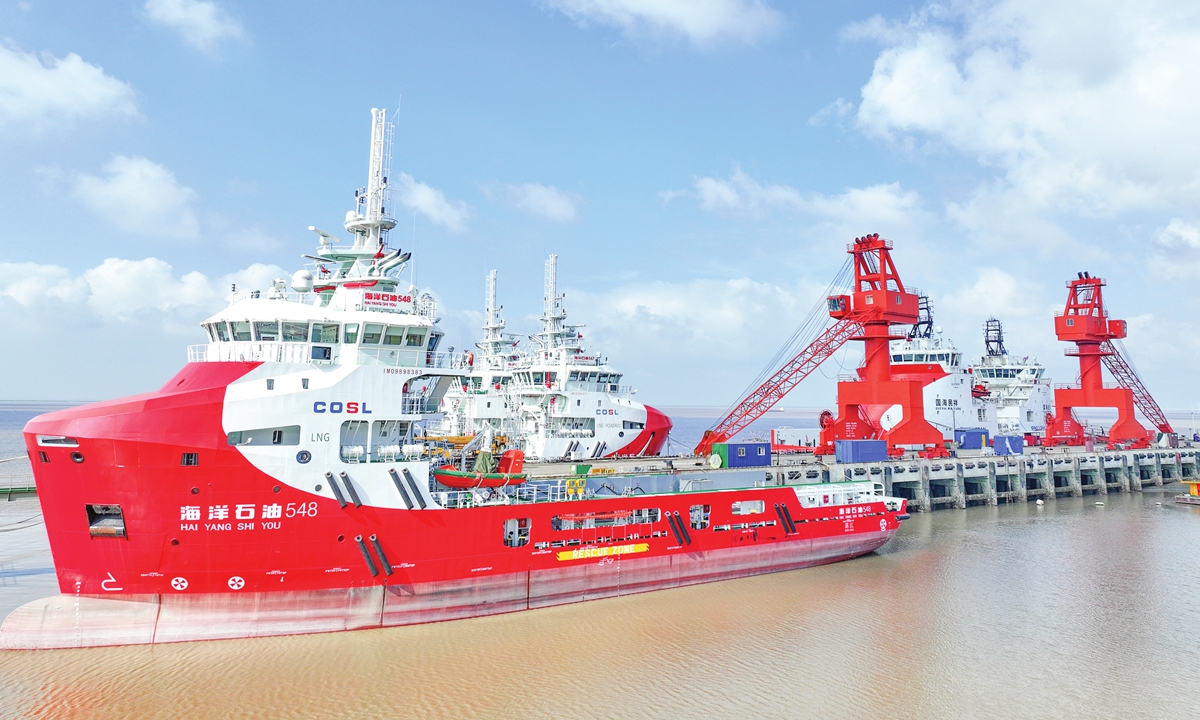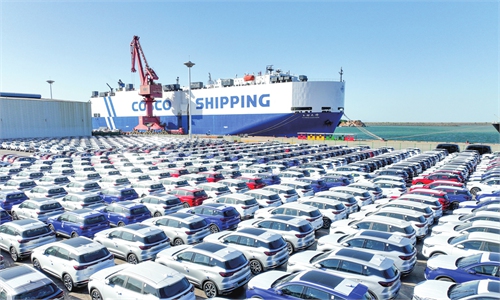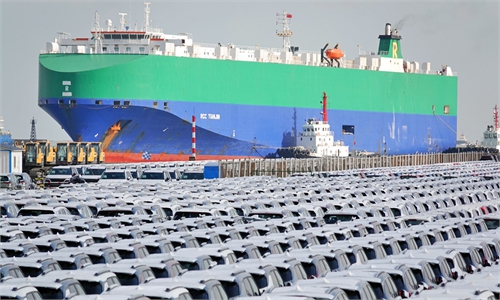
China successfully delivers the world's largest LNG-powered guardian ship in East China's Jiangsu Province on August 1, 2022. Photo: VCG
In January this year, a total of 17 new orders for pure car and truck carriers (PCTC), with 510,000 deadweight tons (DWT) and 152,000 parking spots all fell onto the laps of Chinese shipping manufacturers, data from UK-based Clarkson Research said.
State-owned giant China State Shipbuilding Corp (CSSC) claimed nearly 50 percent of all PCTC orders in January, achieving another breakthrough in global market share.
In recent years, China's booming auto exports has driven the rapid development of the PCTC construction market. Aided with advanced judgment and layout, domestic shipbuilders have broken the monopoly of foreign shipping companies such as Japan and South Korea and continuously increased their global market share.
Experts noted that in addition to the rapid development of PCTC manufacturing, China's shipbuilding industry efficiently delivered high-quality products such as liquefied natural gas (LNG) carriers and container vessels during the pandemic, demonstrating the strong resilience of the country's manufacturing industry despite uncertainties.
Rising vehicle exports
Data from the China Association of Automobile Manufactures showed that in 2022, China exported 3.11 million vehicles, up 54.4 percent from 2021, while the export of new-energy vehicles recorded a year-on-year increase of 120 percent to 679,000.
"Thanks to the rapid development of the country's booming car exports, the sector's advanced technology, the PCTC building sector has attained bright results in recent years," Zheng Ping, chief analyst of industry news chineseport.cn, told the Global Times on Sunday.
Since 2021, CSSC has received orders for 35 PCTC vessels with car-carrying capacities of 7,000 to 9,200, with a global market share of 27 percent.
In addition to PCTC construction, domestic shipbuilders also made breakthroughs in other ship-building products.
Large cruise ships, LNG vessels, and aircraft carriers are known as the "pearls in the crown" of the shipbuilding industry. The LNG carrier is widely known as a vessel of high-tech, high-value, and high-reliability across global shipbuilding markets.
According to a statement sent to the Global Times, Hudong-Zhonghua Shipbuilding Group Co, one of the major shipbuilding enterprises under the flag of CSSC, said that in 2022, the company delivered a total of 16 vessels with 1.336 million DWT, of which medium and high-end products such as LNG carriers, large and ultra-large container vessels accounted for 90 percent.
In 2022, the company took a total of 47 new ship orders, with 4,334,700 DWT, including 38 orders for large LNG carriers, which set a record for the highest number of annual orders for LNG carriers in Chinese shipyards and ranks second in the world.
In August 2022, a 24,116-standard container ship built by the company was successfully dispatched from the dock at Changxing Shipbuilding Base in Shanghai. This is the first container ship with the largest container volume built in the world so far, marking a new era in the world's ultra-large container ship construction led by Chinese shipbuilders.
In February 2023, the enterprise delivered an 80,000-cubic-meter LNG carrier, which is currently the world's largest river-sea intermodal LNG carrier, to Shenzhen Gas Co, marking the start of the shipbuilder's new journey to implement the strategy of doubling LNG carrier production capacity.
Dalian Shipbuilding Industry Co, another enterprise under the CSSC, told the Global Times on Sunday that in 2022, the company undertook the assemblage of 44 vessels of ship products, amounting to 26.82 billion yuan ($3.86 billion), with a year-on-year increase of 71.3 percent.
In addition, the firm achieved its first breakthrough of self-developed LNG carriers, with 6 contracts coming into effect and 17 contracts signed in total.
The latest data from the China Association of the National Shipbuilding Industry (CANSI) showed that China led the world in terms of vessel completion and orders in 2022. China held 47.3 percent of the global market in vessel completion, with 55.2 percent of new orders and 49.0 percent of orders on hand.
Data from UK-based Clarkson Research also revealed that China topped the global list for new orders in 2022, accounting for 49 percent of the total orders worldwide.
Opportunities & challenges
In the next three to four years, Chinese shipping enterprises will likely greet its peak of ship delivery, of which the proportion of high-tech ships will be significantly increased, the CANSI said. In 2023-2024, China plans to deliver 44 large container ships of 15,000 TEU, accounting for more than 20 percent of shipbuilding completions that year; while 2025-2026 will see a concentrated delivery of large LNG ships.
For the new opportunities in the shipbuilding industry, industry experts are sober-minded. Song Wei, a senior official from Hudong-Zhonghua Shipbuilding Group Co, said that the South Korean shipbuilding industry occupies a greater advantage in high value-added ship type, mainly because of its high localization of key equipment or materials, which makes the cost lower. "In order to become a ship-building power, China should overcome the problems," Song noted.
With the formation of environmental protection regulations and policy frameworks in the international shipping industry, the construction of green and environmentally friendly ships will become a new opportunity for shipyards, experts said.
For large ships, the development of green industry mainly lies in using less fossil fuel, Song noted. Considering the storage capacity of fuel and the convenience of replenishment, now most ships are powered by LNG and carbon dioxide is recovered by adding a carbon capture device on board. In the future, shipyards will develop ship models that use ammonia or hydrogen as fuel.
Meanwhile, Zheng warned that Chinese shipbuilding companies should be aware of the coming headwinds as the global economy reels in elevated inflation and low growth.
"Due to the lack of manpower and travel restrictions, the cost of international marine transport edged up during the pandemic, which resulted in some ship-owners to enlarge their transport capacity by placing more orders," said Zheng.
At present, the pandemic is subsiding, and the cost of marine transport is dropping, he noted. "If the global economy keeps facing headwinds, some Chinese shipbuilders may have to face the risks of more orders cancellations or demands for delayed deliveries," said Zheng.


